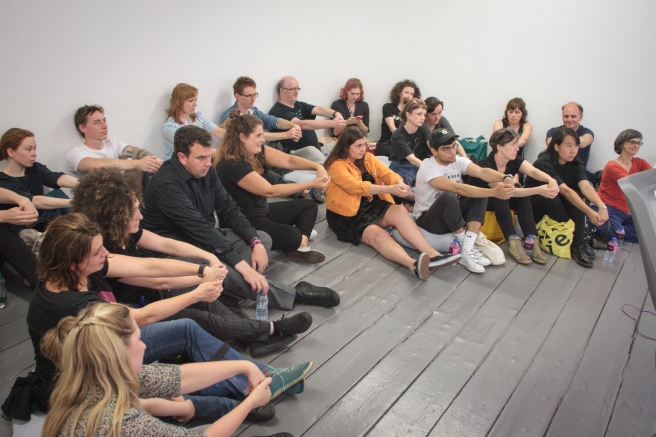by Sara Muthi

When we think about a balanced lifestyle we rarely think about the balance of our brains. While our consumption of sustenance and physical activity fuels our precious bodies to build strength and maintain health within the flesh that wraps our bones, we often neglect the balance of our minds.
What Sara French manages to do within the performance Rooting for Wimps is provide an accessible, interactive and engaging lesson into our brain’s hemispheres. Benefits and solutions to the problem of our left-hemispheres are also uniquely addressed. In our left brain, there is a world…
where bureaucracy flourishes, the technical becomes important, uniqueness is lost, an obsession to govern and control seethe through every crevice of modern life. Our right hemisphere sees the world on a broader plain. That’s where we want to be. That’s who we want to be, the life force power of the universe.

Rooting for Wimps was not a lecture or seminar, French created a refreshing space in which striving for the betterment of ourselves, and by proxy society, I believe I was not alone in experiencing. This performance is an encouragement by French, a rooting for us to begin to take control of our minds, our strength and our agency and it starts with 3 simple exercises, 3 times a week:

3 sets of 30 jumps on your left leg.
Approx. 20 back curls and then presses, using a dumbbell on your left arm.
2 sets of 1 min running on your left leg, with 10 seconds rest between.
These simple exercises are not about strength, endurance or stamina, French states it’s about balancing your left and your right.

As a “rightie”, I have myself noticed something which has been proven and French recounts within the script of her performance. Humans tend to prefer things that are in front of their dominant side, their comfort zone. It’s natural and impulsive. It’s research like this that would make you feel claustrophobic within your mind, and is what French describes as feeling trapped inside her own body. Making automated choices you never knew you were making is not an easy truth to process. Being on autopilot when you thought you were in the pilot’s seat can be unsettling. These concepts don’t just have small implications in our everyday decision making, but also in major political discourse as well. We cannot begin to fathom how many of our choices are automated or nudged certain directions due to things outside of our control.

French is rooting for you and your cognitive liberty. Escape your left brained ways to finally tap into your potential, be the lifeforce power of the universe. By following these simple exercises our minds may be moulded and lean towards the right side of our mind, allowing us a less than illusionary version of agency, agency which is consistently under threat. By gaining awareness, and actively improving our cognitive agency, we may begin to think for ourselves and regain control of our minds, our society and our democracy.
“Let’s be our own choice architects.”
French achieved a complex goal, a method to achieve an escalated human experience, by developing awareness of your mind through the persona of a simple, a relatable and familiar character. to many of us. An online video tutorial often features a character which is fun, motivating, educational and occasionally convincing convicting. All these traits are for the betterment and growth of the viewer, a persona in which French embodied effortlessly. The day of the performance, an air of motivation swept across the audience as she interacted directly with some enthusiastic and less than willing participants, bridging the gap between performer and spectator, counting together, stretching together, and spotting each other.

French’s persona never broke from the upbeat character, nor was it ever misleading. While the piece was intentionally accessible to a wide audience, its implications were clear: a need for cognitive liberty was read between her words and actions with ease.
The success of the accessibility of this performance is a testament to the artist, but also the curator Roisin Bohan, whom organised this four-part performance series, each being incredibly stimulating (including works by Lisa Freeman and Ciara Lenihan, Mark Buckeridge and the ALL CHOIR, and Celina Muldoon), yet thoroughly enjoyable and thought provoking. Rooting for Wimps is the last in this series.

French has crafted a performance that has shone a light on a widely unnoticed, yet invaluable information about cognitive liberty which is not beyond our reach, or genetics. Through persistence and awareness, we too may “improve our problem-solving skills, develop better spatial awareness, hone on home in on empathy, be more playful and master the skill of thinking up and telling compelling narratives, with 3 simple exercise, 3 times a week.”
Rooting for Wimps, performed by Sara French, curated by Róisín Bohan, took place on July 15th, 2017, at the Temple Bar Gallery + Studios. Images by Gary Teeling.




